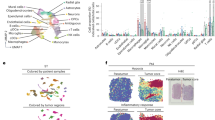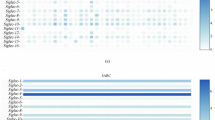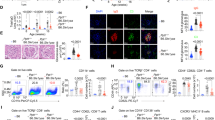Abstract
Neonatal PMN (polymorphonuclear neutrophils) exhibit altered inflammatory responsiveness and greater longevity compared with adult PMN; however, the involved mechanisms are incompletely defined. Receptors containing immunoreceptor tyrosine-based inhibitory motif (ITIM) domains promote apoptosis by activating inhibitory phosphatases, such as Src homology domain 2-containing tyrosine phosphatase-1 (SHP-1), that block survival signals. Sialic acid-binding immunoglobulin-like lectin (Siglec)-9, an immune inhibitory receptor with an ITIM domain, has been shown to induce cell death in adult PMN in association with SHP-1. To test our hypothesis that neonatal PMN inflammatory function may be modulated by unique Siglec-9 and SHP-1 interactions, we compared expression of these proteins in adult and neonatal PMN. Neonatal PMN exhibited diminished cellular expression of Siglec-9, which was phosphorylated in the basal state. Granulocyte-macrophage colony-stimulating factor (GM-CSF) treatment decreased Siglec-9 phosphorylation levels in neonatal PMN but promoted its phosphorylation in adult PMN, observations associated with altered survival signaling. Although SHP-1 expression was also diminished in neonatal PMN, GM-CSF treatment had minimal effect on phosphorylation status. Further analysis revealed that Siglec-9 and SHP-1 physically interact, as has been observed in other immune cells. Our data suggest that age-specific interactions between Siglec-9 and SHP-1 may influence the altered inflammatory responsiveness and longevity of neonatal PMN.
Similar content being viewed by others
Log in or create a free account to read this content
Gain free access to this article, as well as selected content from this journal and more on nature.com
or
Abbreviations
- fMLP:
-
formyl-methionine-leucine-phenylalanine
- ITIM:
-
immunoreceptor tyrosine-based inhibitory motif
- MFI:
-
mean fluorescence intensity
- rhGM-CSF:
-
recombinant human granulocyte-macrophage colony-stimulating factor
- SHP-1:
-
Src homology domain 2-containing tyrosine phosphatase-1
- Siglec:
-
Sialic acid-binding immunoglobulin-like lectin
References
Dransfield I, Rossi AG, Brown SB, Hart SP 2005 Neutrophils: dead or effete? Cell surface phenotype and implications for phagocytic clearance. Cell Death Differ 12: 1363–1367
Luo HR, Loison F 2008 Constitutive neutrophil apoptosis: mechanisms and regulation. Am J Hematol 83: 288–295
Haslett C 1997 Granulocyte apoptosis and inflammatory disease. Br Med Bull 53: 669–683
Allgaier B, Shi M, Luo D, Koenig JM 1998 Spontaneous and Fas-mediated apoptosis are diminished in umbilical cord blood neutrophils compared with adult neutrophils. J Leukoc Biol 64: 331–336
Koenig JM, Stegner JJ, Schmeck AC, Saxonhouse MA, Kenigsberg LE 2005 Neonatal neutrophils with prolonged survival exhibit enhanced inflammatory and cytotoxic responsiveness. Pediatr Res 57: 424–429
Kotecha S, Mildner RJ, Prince LR, Vyas JR, Currie AE, Lawson RA, Whyte MK 2003 The role of neutrophil apoptosis in the resolution of acute lung injury in newborn infants. Thorax 58: 961–967
Oei J, Lui K, Wang H, Henry R 2003 Decreased neutrophil apoptosis in tracheal fluids of preterm infants at risk of chronic lung disease. Arch Dis Child Fetal Neonatal Ed 88: F245–F249
Speer CP 2006 Inflammation and bronchopulmonary dysplasia: a continuing story. Semin Fetal Neonatal Med 11: 354–362
Luo D, Schowengerdt KO Jr, Stegner JJ, May WS Jr, Koenig JM 2003 Decreased functional caspase-3 expression in umbilical cord blood neutrophils is linked to delayed apoptosis. Pediatr Res 53: 859–864
Hanna N, Vasquez P, Pham P, Heck DE, Laskin JD, Laskin DL, Weinberger B 2005 Mechanisms underlying reduced apoptosis in neonatal neutrophils. Pediatr Res 57: 56–62
Ravetch JV, Lanier LL 2000 Immune inhibitory receptors. Science 290: 84–89
Yousefi S, Simon HU 2003 SHP-1: a regulator of neutrophil apoptosis. Semin Immunol 15: 195–199
Crocker PR, Paulson JC, Varki A 2007 Siglecs and their roles in the immune system. Nat Rev Immunol 7: 255–266
Crocker PR, Varki A 2001 Siglecs, sialic acids, and innate immunity. Trends Immunol 22: 337–342
Varki A, Angata T 2006 Siglecs—the major subfamily of I-type lectins. Glycobiology 16: 1R–27R
Zhang JQ, Nicoll G, Jones C, Crocker PR 2000 Siglec-9, a novel sialic acid binding member of the immunoglobulin superfamily expressed broadly on human blood leukocytes. J Biol Chem 275: 22121–22126
Erickson-Miller CL, Freeman SD, Hopson CB, D'Alessio KJ, Fischer EI, Kikly KK, Abrahamson JA, Holmes SD, King AG 2003 Characterization of Siglec-5 (CD170) expression and functional activity of anti-Siglec-5 antibodies on human phagocytes. Exp Hematol 31: 382–388
von Gunten S, Yousefi S, Seitz M, Jakob SM, Schaffner T, Seger R, Takala J, Villiger PM, Simon HU 2005 Siglec-9 transduces apoptotic and nonapoptotic death signals into neutrophils depending on the proinflammatory cytokine environment. Blood 106: 1423–1431
Avril T, Floyd H, Lopez F, Vivier E, Crocker PR 2004 The membrane-proximal immunoreceptor tyrosine-based inhibitory motif is critical for the inhibitory signaling mediated by Siglecs-7 and -9, CD33-related Siglecs expressed on human monocytes and NK cells. J Immunol 173: 6841–6849
Fortin CF, Larbi A, Lesur O, Douziech N, Fulop T Jr 2006 Impairment of SHP-1 down-regulation in the lipid rafts of human neutrophils under GM-CSF stimulation contributes to their age-related, altered functions. J Leukoc Biol 79: 1061–1072
Kirchhofer D, Riederer MA, Baumgartner HR 1997 Specific accumulation of circulating monocytes and polymorphonuclear leukocytes on platelet thrombi in a vascular injury model. Blood 89: 1270–1278
Daigle I, Yousefi S, Colonna M, Green DR, Simon HU 2002 Death receptors bind SHP-1 and block cytokine-induced anti-apoptotic signaling in neutrophils. Nat Med 8: 61–67
Cuevas B, Lu Y, Watt S, Kumar R, Zhang J, Siminovitch KA, Mills GB 1999 SHP-1 regulates Lck-induced phosphatidylinositol 3-kinase phosphorylation and activity. J Biol Chem 274: 27583–27589
Zhu D, Hattori H, Jo H, Jia Y, Subramanian KK, Loison F, You J, Le Y, Honczarenko M, Silberstein L, Luo HR 2006 Deactivation of phosphatidylinositol 3,4,5-trisphosphate/Akt signaling mediates neutrophil spontaneous death. Proc Natl Acad Sci USA 103: 14836–14841
Datta SR, Dudek H, Tao X, Masters S, Fu H, Gotoh Y, Greenberg ME 1997 Akt phosphorylation of BAD couples survival signals to the cell-intrinsic death machinery. Cell 91: 231–241
Brumell JH, Chan CK, Butler J, Borregaard N, Siminovitch KA, Grinstein S, Downey GP 1997 Regulation of Src homology 2-containing tyrosine phosphatase 1 during activation of human neutrophils. Role of protein kinase C. J Biol Chem 272: 875–882
Klein JB, Rane MJ, Scherzer JA, Coxon PY, Kettritz R, Mathiesen JM, Buridi A, McLeish KR 2000 Granulocyte-macrophage colony-stimulating factor delays neutrophil constitutive apoptosis through phosphoinositide 3-kinase and extracellular signal-regulated kinase pathways. J Immunol 164: 4286–4291
Nishizumi H, Horikawa K, Mlinaric-Rascan I, Yamamoto T 1998 A double-edged kinase Lyn: a positive and negative regulator for antigen receptor-mediated signals. J Exp Med 187: 1343–1348
Yan SR, Byers DM, Bortolussi R 2004 Role of protein tyrosine kinase p53/56lyn in diminished lipopolysaccharide priming of formylmethionylleucyl- phenylalanine-induced superoxide production in human newborn neutrophils. Infect Immun 72: 6455–6462
Jia SH, Parodo J, Kapus A, Rotstein OD, Marshall JC 2008 Dynamic regulation of neutrophil survival through tyrosine phosphorylation or dephosphorylation of caspase-8. J Biol Chem 283: 5402–5413
Freeman SD, Kelm S, Barber EK, Crocker PR 1995 Characterization of CD33 as a new member of the sialoadhesin family of cellular interaction molecules. Blood 85: 2005–2012
Koenig JM, Yoder MC 2004 Neonatal neutrophils: the good, the bad, and the ugly. Clin Perinatol 31: 39–51
Acknowledgements
We thank the obstetricians and the Labor & Delivery staff at SSM St. Mary's Health Center and particularly the adult blood donors for helping us obtain samples critical for our studies.
Author information
Authors and Affiliations
Corresponding author
Additional information
Supported by Grant HD47401 from NIH/NICHD (to J.M.K), the Fleur-de-Lis Foundation (to R.R.), and the Pediatric Research Institute, Department of Pediatrics, Saint Louis University (to J.M.K.).
Rights and permissions
About this article
Cite this article
Rashmi, R., Bode, B., Panesar, N. et al. Siglec-9 and SHP-1 Are Differentially Expressed in Neonatal and Adult Neutrophils. Pediatr Res 66, 266–271 (2009). https://doi.org/10.1203/PDR.0b013e3181b1bc19
Received:
Accepted:
Issue date:
DOI: https://doi.org/10.1203/PDR.0b013e3181b1bc19
This article is cited by
-
Neonatal neutrophils stimulated by group B Streptococcus induce a proinflammatory T-helper cell bias
Pediatric Research (2018)
-
Cell Death Modulation by Intravenous Immunoglobulin
Journal of Clinical Immunology (2010)



